
Natron is a naturally occurring mixture of sodium carbonate decahydrate (Na2CO3·10H2O, a kind of soda ash) and around 17% sodium bicarbonate (also called baking soda, NaHCO3) along with small quantities of sodium chloride and sodium sulfate. Natron is white to colourless when pure, varying to gray or yellow with impurities. Natron deposits are sometimes found in saline lake beds which arose in arid environments. Throughout history natron has had many practical applications that continue today in the wide range of modern uses of its constituent mineral components.

An evaporite is a water-soluble sedimentary mineral deposit that results from concentration and crystallization by evaporation from an aqueous solution. There are two types of evaporite deposits: marine, which can also be described as ocean deposits, and non-marine, which are found in standing bodies of water such as lakes. Evaporites are considered sedimentary rocks and are formed by chemical sediments.

Halite, commonly known as rock salt, is a type of salt, the mineral (natural) form of sodium chloride (NaCl). Halite forms isometric crystals. The mineral is typically colorless or white, but may also be light blue, dark blue, purple, pink, red, orange, yellow or gray depending on inclusion of other materials, impurities, and structural or isotopic abnormalities in the crystals. It commonly occurs with other evaporite deposit minerals such as several of the sulfates, halides, and borates. The name halite is derived from the Ancient Greek word for "salt", ἅλς (háls).

Trona (trisodium hydrogendicarbonate dihydrate, also sodium sesquicarbonate dihydrate, Na2CO3•NaHCO3•2H2O) is a non-marine evaporite mineral. It is mined as the primary source of sodium carbonate in the United States, where it has replaced the Solvay process used in most of the rest of the world for sodium carbonate production. Turkey is also a major producer.

Thermonatrite is a naturally occurring evaporite mineral form of sodium carbonate, Na2CO3·H2O.

Thénardite is an anhydrous sodium sulfate mineral, Na2SO4 which occurs in arid evaporite environments, specifically lakes and playas. It also occurs in dry caves and old mine workings as an efflorescence and as a crusty sublimate deposit around fumaroles. It occurs in volcanic caves on Mount Etna, Italy. It was first described in 1825 for an occurrence in the Espartinas Saltworks, Ciempozuelos, Madrid, Spain and was named for the French chemist, Louis Jacques Thénard (1777–1826).
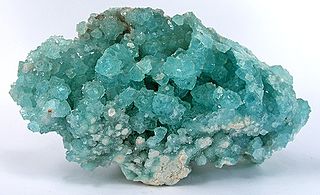
Boracite is a magnesium borate mineral with formula: Mg3B7O13Cl. It occurs as blue green, colorless, gray, yellow to white crystals in the orthorhombic - pyramidal crystal system. Boracite also shows pseudo-isometric cubical and octahedral forms. These are thought to be the result of transition from an unstable high temperature isometric form on cooling. Penetration twins are not unusual. It occurs as well formed crystals and dispersed grains often embedded within gypsum and anhydrite crystals. It has a Mohs hardness of 7 to 7.5 and a specific gravity of 2.9. Refractive index values are nα = 1.658 - 1.662, nβ = 1.662 - 1.667 and nγ = 1.668 - 1.673. It has a conchoidal fracture and does not show cleavage. It is insoluble in water (not to be confused with borax, which is soluble in water).

Searles Lake is an endorheic dry lake in the Searles Valley of the Mojave Desert, in northwestern San Bernardino County, California. The lake in the past was also called Slate Range Lake and Borax Lake.
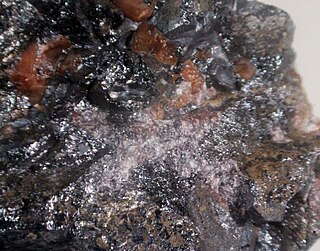
The rare mineral adelite, is a calcium, magnesium, arsenate with chemical formula CaMgAsO4OH. It forms a solid solution series with the vanadium-bearing mineral gottlobite. Various transition metals substitute for magnesium and lead replaces calcium leading to a variety of similar minerals in the adelite - duftite group.
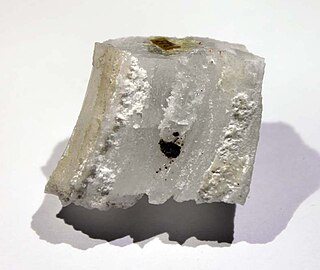
Mendozite is a sulfate mineral, one of the alum series, with formula NaAl(SO4)2·11H2O. It is a hydrated form of sodium aluminium sulfate (soda alum).
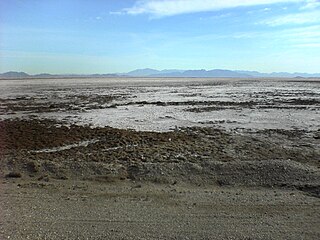
Bristol Lake is a dry lake in the Mojave Desert of San Bernardino County, California, 42 km (26 mi) northeast of Twentynine Palms.

Tincalconite is a hydrous sodium borate mineral closely related to borax, and is a secondary mineral that forms as a dehydration product of borax. Its formula is Na2B4O7·5H2O or Na2[B4O5(OH)4]·3H2O.

Searles Valley Minerals Inc. is a raw materials mining and production company with corporate offices in Overland Park, Kansas. It is owned by the Indian company Nirma. It has major operations in the Searles Valley centered in Trona, California where it is the town's largest employer. The company produces borax, boric acid, soda ash, salt cake, and salt. It also owns the Trona Railway.

Nahcolite is a soft, colourless or white carbonate mineral with the composition of sodium bicarbonate (NaHCO3) also called thermokalite. It crystallizes in the monoclinic system.
Mosesite is a very rare mineral found in few locations. It is a mercury mineral found as an accessory in deposits of mercury, often in conjunction with limestone. It is known to be found in the U.S. states of Texas and Nevada, and the Mexican states of Guerrero and Querétaro. It was named after Professor Alfred J. Moses (1859–1920) for his contributions to the field of mineralogy in discovering several minerals found alongside mosesite. The mineral itself is various shades of yellow and a high occurrence of spinel twinning. It becomes isotropic when heated to 186 °C (367 °F).

Raspite is a mineral, a lead tungstate; with the formula PbWO4. It forms yellow to yellowish brown monoclinic crystals. It is the low temperature monoclinic dimorph of the tetragonal stolzite.
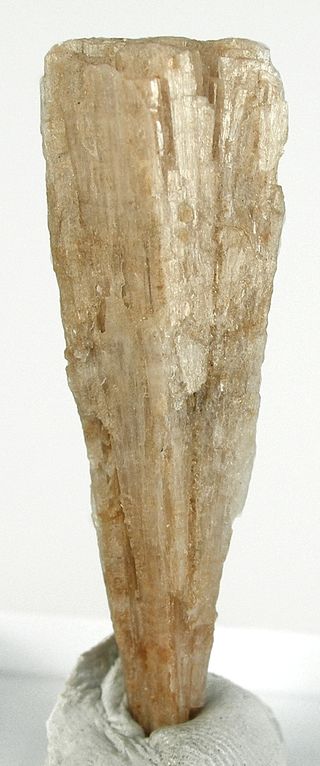
Syngenite is an uncommon potassium calcium sulfate mineral with formula K2Ca(SO4)2·H2O. It forms as prismatic monoclinic crystals and as encrustations.

Marshite (CuI) is a naturally occurring isometric halide mineral with occasional silver (Ag) substitution for copper (Cu). Solid solution between the silver end-member miersite and the copper end-member marshite has been found in these minerals from deposits in Broken Hill, Australia. The mineral's name is derived from the person who first described it, an Australian mineral collector named Charles W. Marsh. Marsh drew attention to native copper iodide (Marshite) in the 1800s emphasizing its natural occurrence, it is not to be confused with copper (I) iodide a substance commonly synthesized in laboratory settings.

Bieberite (CoSO4 · 7H2O) is a pinkish red colored sulfate mineral high in cobalt content. The name is derived from the type locality at the copper deposit in Bieber, Hesse, Germany. It has been described and reported as far back as the 1700s. Bieberite primarily occurs as a secondary mineral, forming in cobalt-bearing arsenide and sulfide deposits through oxidation.

The Potash wars were a series of events that took place from 1910 to 1915 in the Searles Valley near Searles Lake, a dry lake, near the current town of Trona in the San Bernardino County of California. The Potash wars gained national and international news at the time due to the involvement of famous lawman Wyatt Earp and the importance of the valley's supply of potash at the time. Potash is an important crop fertilizer and the Searles Valley was a major supplier in the 1910s.



















